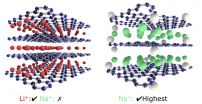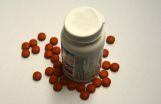(Press-News.org) MANHATTAN, KANSAS -- A Kansas State University engineering team has discovered some of graphene oxide's important properties that can improve sodium- and lithium-ion flexible batteries.
Gurpreet Singh, assistant professor of mechanical and nuclear engineering, and Lamuel David, doctoral student in mechanical engineering, India, published their findings in the Journal of Physical Chemistry in the article "Reduced graphene oxide paper electrode: Opposing effect of thermal annealing on Li and Na cyclability."
Graphene oxide is an insulating and defective version of graphene that can be converted to a conductor or a semiconductor when it is heated. Singh and his team studied graphene oxide sheets as flexible paper electrodes for sodium- and lithium-ion batteries.
The researchers found that sodium storage capacity of paper electrodes depends on the distance between the individual layers that can be tuned by heating it in argon or ammonia gas. For example, reduced graphene oxide sheets, or rGO, produced at high temperature have near zero sodium capacity, while reduced graphene oxide sheets produced at 500 degrees C have the maximum capacity.
"The observation is important because graphite, which is a precursor for making graphene oxide, has negligible capacity for sodium and has long been ruled out as viable electrode for sodium-batteries," Singh said. "Graphite is the material of choice in current lithium-ion batteries because the interlayer spacing is just right for the smaller size lithium ions to diffuse in and out."
The researchers are the first to show that a flexible paper composed entirely of graphene oxide sheets can charge and discharge with sodium-ions for more than 1,000 cycles. Sodium perchlorate salt dissolved in ethylene carbonate served as the electrolyte in their cells.
"Most lithium electrode materials for sodium batteries cannot even last for more than a few tens of charge and discharge cycles because sodium is much larger than lithium and causes enormous volume changes and damage to the host material," Singh said. "This design is unique because the distance between individual graphene layers is large enough to allow fast insertion and extraction of the sodium ions, thanks to the oxygen and hydrogen atoms that prevent sheets from restacking."
Singh and his team also studied the mechanical behavior of the electrodes made of reduced graphene oxide sheets. The researchers measured the strain required to tear apart the electrodes. Through videography, they showed the ability of the crumpled graphene oxide papers to sustain large strains before failing.
"Such measurements and study of failure mechanisms are important for designing long-life batteries because you want the electrode to be able to expand and contract repeatedly without fracture for thousands of cycles, especially for larger nonlithium metal-ion batteries," Singh said. "These days, almost every one is using crumpled graphene as either the conducting agent or elastic support or both."
Earlier this year, Singh and his team demonstrated large-scale synthesis of few-layer-thick sheets of molybdenum disulfide. They also showed the molybdenum disulfide/graphene composite paper has potential as a high-capacity electrode for sodium-ion battery. In that research, the scientists used graphene as an electron conductor for the molybdenum disulfide sheets and observed graphene to be largely inactive toward sodium.
Their latest research has shown that unlike sodium, the lithium capacity of rGO increases with increasing rGO synthesis temperature reaching maximum value for sample produced at 900 degrees C.
"It is only now we realize that sodium capacity of graphene, or rGO, is dependent on its processing temperature," Singh said. "The rGO specimens in our previous study were prepared at 900 degrees C."
Singh said that research into sodium and nonlithium batteries is important for several reasons. As the focus shifts from vehicles to stationary energy storage systems and large vehicles, stationary batteries need to be cheaper, safe and environmentally benign. Because of its large abundance, sodium is a potential candidate for replacing lithium-ion batteries.
By focusing on nanotechnology, Singh and his team were able to explore and design materials that can store sodium-ions reversibly and without damage. They found their answer in graphene oxide, which can cycle sodium-ions for more than 1,000 cycles.
Singh and his team will continue exploring new nanomaterials and focus on materials that can be mass-produced in a cost-effective manner.
"We would like to perform fundamental studies to understand the origins of first cycle loss, voltage hysteresis, and capacity degradation that are common to metal-ion battery anodes prepared from 2-D layered crystals such as transition metal chalcogenides, graphene, etc.," Singh said.
The researchers are also looking at other nanomaterials that have been ruled out as battery electrodes, such as boron nitride sheets and silicon-nitrogen based ceramics.
INFORMATION:
Singh has received support from the National Science Foundation.
Many genetic mutations in visual pigments, spread over millions of years, were required for humans to evolve from a primitive mammal with a dim, shadowy view of the world into a greater ape able to see all the colors in a rainbow.
Now, after more than two decades of painstaking research, scientists have finished a detailed and complete picture of the evolution of human color vision. PLOS Genetics is publishing the final pieces of this picture: The process for how humans switched from ultraviolet (UV) vision to violet vision, or the ability to see blue light.
"We ...
Ibuprofen, a common over-the-counter drug used to relieve pain and fever, could hold the keys to a longer healthier life, according to a study by researchers at the Buck Institute for Research on Aging. Publishing in PLoS Genetics on December 18th, scientists showed that regular doses of ibuprofen extended the lifespan of yeast, worms and fruit flies.
"There is a lot to be excited about," said Brian Kennedy, PhD, CEO of the Buck Institute, who said treatments, given at doses comparable to those used in humans, extended lifespan an average of 15 percent in the model ...
Many animals may have a previously under-appreciated ability to make up for lost time with more effort, according to new research publishing this week in PLOS Computational Biology.
This capability could help scientists better understand how animals make efficient decisions in changing environments -- and ultimately help ensure the survival of a species.
Researchers from Princeton University challenge the conventional view that animals face a simple trade-off between the speed and the accuracy of their decisions. Adrian de Froment, Daniel Rubenstein and Simon Levin ...
Most vaccines work by inducing an immune response characterized by neutralizing antibodies against the respective pathogen. An effective HIV vaccine has remained elusive so far, but researchers have continued to make progress, often employing innovative methods. A study published on December 18th in PLOS Pathogens reports that a combination of antibodies from llamas can neutralize (destroy) a wide range of circulating HIV viruses.
After initial disappointment that HIV vaccine candidates were unable to elicit neutralizing antibodies, researchers found that some HIV-infected ...
COLLEGE STATION -- A common over-the-counter drug that tackles pain and fever may also hold keys to a longer, healthier life, according to a Texas A&M AgriLife Research scientist.
Regular doses of ibuprofen extended the lifespan of multiple species, according to research published in the journal Public Library of Science-Genetics.
"We first used baker's yeast, which is an established aging model, and noticed that the yeast treated with ibuprofen lived longer," said Dr. Michael Polymenis, an AgriLife Research biochemist in College Station. "Then we tried the same process ...
This news release is available in Japanese, French, Spanish and Chinese on EurekAlert! Chinese. The Rosetta spacecraft caught up with the comet known as 67P/Churyumov-Gerasimenko beyond Mars this August, and its preliminary results--along with the studies it will allow in the near-future--top this year's list of the most important scientific breakthroughs, according to the editors of Science.
This annual list of groundbreaking scientific achievements, selected by Science and its international nonprofit publisher, AAAS, also includes groundbreaking advances in medicine, ...
Research led by the Teichmann group on the Wellcome Genome Campus has identified a fundamental mechanism for controlling protein function. Published in the journal Science, the discovery has wide-ranging implications for biotechnology and medicine.
The shape of a protein determines its function, for example whether it is able to interact with another protein or with a drug. But a protein's shape is not constant - it may change in response to different conditions, or simply as a matter of course.
Understanding how this process works is key to figuring out how to manipulate ...
In the decade since the genome was sequenced in 2003, scientists and doctors have struggled to answer an all-consuming question: Which DNA mutations cause disease?
A new computational technique developed at the University of Toronto may now be able to tell us.
A Canadian research team led by professor Brendan Frey has developed the first method for 'ranking' genetic mutations based on how living cells 'read' DNA, revealing how likely any given alteration is to cause disease. They used their method to discover unexpected genetic determinants of autism, hereditary cancers ...
The majority of RNA expression differences between individuals have no connection to the abundance of a corresponding protein, report scientists from the University of Chicago and Stanford University in Science on Dec. 18. The findings point to a yet-unidentified cellular mechanism that regulates gene expression and suggest studies that rely only on RNA measurements to characterize gene function require further analysis.
"The chief assumption for studies of RNA differences is that they ultimately reflect differences in an end product, which is protein," said senior study ...
HANOVER, N.H. - Human cells are protected by a largely impenetrable molecular membrane, but researchers have built the first artificial transporter protein that carries individual atoms across membranes, opening the possibility of engineering a new class of smart molecules with applications in fields as wide ranging as nanotechnology and medicine.
The study, which appears Friday, Dec. 19, in the journal Science, is a milestone in designing and understanding membrane proteins. A PDF is available upon request. The study was conducted by researchers from Dartmouth College, ...




